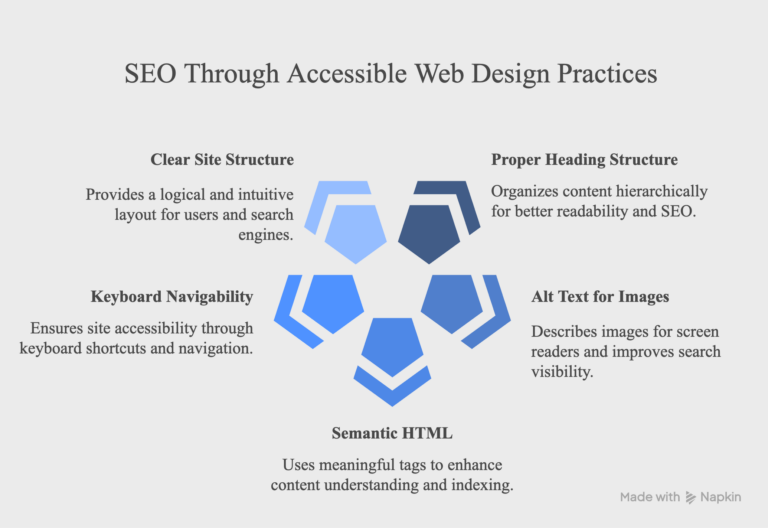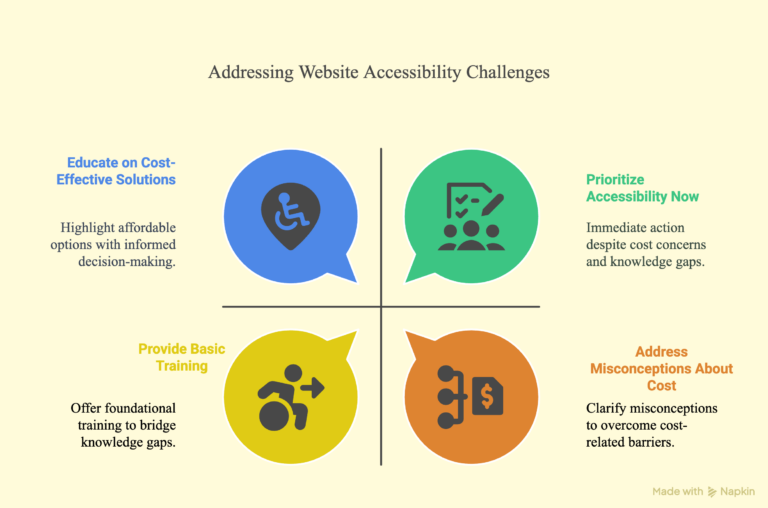Greetings! I'm Aneesh Sreedharan, CEO of 2Hats Logic Solutions. At 2Hats Logic Solutions, we are dedicated to providing technical expertise and resolving your concerns in the world of technology. Our blog page serves as a resource where we share insights and experiences, offering valuable perspectives on your queries.

Quick Summary
Ignoring web accessibility doesn’t just risk legal trouble. It also means missing out on over 1 billion potential customers around the world. Making your website accessible helps more people use it easily, boosts your SEO, and keeps you safe from lawsuits. For online stores, accessibility isn’t just the right thing to do. It plays a big role in how well your business performs. It can improve your conversion rates, make customers happier, and help your business grow in the long run.
Have you ever visited a website that was frustratingly difficult to navigate? Now imagine facing that experience daily, with nearly every site you visit.
This is the reality for millions of users with disabilities who encounter inaccessible websites. For businesses, accessibility isn’t just about compliance.
It’s about reaching your entire potential audience and protecting your organization from significant legal and financial consequences.
Not sure if your website is accessible to everyone? Get a free accessibility audit and find out.
Importance of Accessibility in Web Design
Web accessibility ensures people with disabilities can perceive, understand, navigate, and interact with websites and tools. It encompasses visual, auditory, physical, speech, cognitive, and neurological disabilities. When your e-commerce site or web application fails to meet accessibility standards, you’re not just excluding potential customers. This exposes your business to substantial risks.
Accessibility is not a feature or a nice-to-have; it’s a fundamental aspect of product quality and user experience that businesses can no longer afford to ignore.”
Tim Berners-Lee, inventor of the World Wide Web
Risks of Skipping Website Accessibility
The legal framework around digital accessibility has evolved significantly in recent years. The consequences for non-compliant businesses are becoming increasingly severe.
Key Legal Considerations for E-Commerce Businesses
- ADA Title III Applicability
Courts have consistently ruled that websites are “places of public accommodation” under the Americans with Disabilities Act (ADA), making them subject to accessibility requirements. - Surge in Litigation
Web accessibility lawsuits have increased by over 300% since 2018. Retailers and e-commerce businesses are primary targets. - International Compliance Requirements
Beyond the U.S., global regulations like the European Accessibility Act (EAA) and Canada’s Accessible Canada Act impose additional compliance requirements for businesses operating internationally.
Business Protection Tip: Conduct quarterly accessibility audits of your digital properties against WCAG 2.1 AA standards to identify and remediate potential compliance issues before they become legal problems.
Want More Sales? Make Your Website Accessible
Beyond legal risks, inaccessible websites directly impact your business performance in ways that often go unrecognized.
1. Excluded customer segments represent massive market potential
Over 1 billion people worldwide live with some form of disability (15% of the global population). People with disabilities control over $1.2 trillion in annual disposable income in the U.S. alone
71% of users with disabilities will immediately leave a website that isn’t accessible
An inaccessible e-commerce site effectively surrenders a significant market segment directly to competitors with more accessible alternatives.
2. SEO performance suffers without accessibility
Many accessibility features directly align with search engine optimization best practices:

- Proper heading structure
- Alt text for images
- Semantic HTML
- Keyboard navigability
- Clear site structure
| Accessibility Feature | SEO Benefit |
| Descriptive alt text | Enhanced image search visibility |
| Proper heading hierarchy | Improved content indexing |
| Transcripts for audio/video | Additional indexable content |
| Keyboard navigability | Better site crawlability |
| Readable text with good contrast | Reduced bounce rates |
3. Better usability benefits all users
Accessibility improvements create better experiences for everyone:
- Mobile users benefit from better touch targets and navigation
- Users in noisy environments benefit from captions
- Users with temporary impairments (like a broken arm) can still navigate your site
- Users with slow internet connections benefit from optimized media
Why Businesses Struggle with Website Accessibility
Despite the clear business case for accessibility, many organizations continue to underinvest in this critical area. Common barriers include:
1. Misconception: “It’s Too Expensive”
The cost of retrofitting accessibility into an existing site is typically 10-30% higher than building it in from the beginning. Meanwhile, the average settlement for an accessibility lawsuit is $25,000-$55,000, excluding legal fees and remediation costs.
2. Knowledge Gaps: “We Don’t Know How”
Many development teams lack training in accessibility standards and testing methodologies. This knowledge gap leads to the perpetuation of inaccessible design patterns.
3. Prioritization Failures: “We’ll Do It Later”
Accessibility often gets deprioritized in favor of new features, only to become an urgent, expensive retrofit when legal demands arise.
Take a look at how you can address these issues and make your website accessible.

Make Your Website Accessible
Implementing accessibility isn’t merely about compliance. It’s about embracing inclusive design as a core business value and competitive advantage.
Your website deserves to be accessible to everyone, and your audience expects it.
Step 1: Assess Your Current Status
Begin with a comprehensive audit against Web Content Accessibility Guidelines (WCAG) 2.1 AA standards and EAA:
Use automated testing using tools like Axe or WAVE. Manual testing can also be done with assistive technologies. User testing with individuals who have disabilities
Step 2: Develop a Remediation Roadmap
Prioritize fixes based on:
- Legal risk exposure (critical barriers)
- User impact (frequency of interaction)
- Implementation complexity
- Business value alignment
Step 3: Embed Accessibility in Your Development Process
- Include accessibility requirements in your definition of “done”
- Implement automated testing in your CI/CD pipeline
- Provide ongoing training for designers and developers
- Designate accessibility champions within teams
Step 4: Document Your Efforts
Maintain detailed records of:
- Accessibility policies
- Audit results
- Remediation efforts
- Training provided
- Testing procedures
Legal protection note: Well-documented good-faith efforts toward accessibility can significantly mitigate legal risks, even when perfect compliance hasn’t yet been achieved.
E-commerce-Specific Accessibility Challenges
Online stores face unique accessibility considerations that require special attention:
1. Product Images and Information
- Multiple images with descriptive alt text
- Detailed product descriptions that don’t rely solely on visual information
- Structured specification data
2. Shopping Cart and Checkout Processes
- Clear error identification and recovery
- No time limits that can’t be adjusted
- Alternative authentication methods
3. Form Completion and Validation
- Clear labeling of all form fields
- Error messages that identify both the error and the solution
- Multiple contact options for assistance
Ready to make your site accessible? Let’s fix those challenges together.
The Future of Digital Accessibility
The accessibility landscape continues to evolve with new technologies and standards:
- AI-assisted accessibility: Automated remediation and real-time adaptations
- Voice commerce: Voice-first interfaces that benefit users with mobility or vision impairments
- Personalized accessibility: User-controlled adjustments to suit individual needs
Forward-thinking businesses are moving beyond compliance to innovation—designing experiences that aren’t just accessible but exceptional for all users.
Conclusion
At 2HatsLogic, we integrate accessibility into our comprehensive e-commerce and web development services from day one. Our approach treats accessibility not as a technical checkbox but as a fundamental business performance driver.
Whether you’re building a new digital commerce presence or enhancing an existing platform, our team ensures website accessibility is seamlessly integrated into every aspect of your digital experience.Contact our accessibility experts today to discuss how we can help make your digital presence both compliant and commercially optimized for all users.
FAQ
What's the first step to improve my website's accessibility?
Begin with an accessibility audit against WCAG 2.1 AA standards, focusing initially on your conversion pathways (product pages, cart, checkout) where accessibility issues most directly impact revenue and legal exposure.
How does improving accessibility benefit all my customers?
Accessibility enhancements create clearer navigation, better mobile experiences, improved site performance, and more intuitive interfaces that benefit all users.
Table of contents



